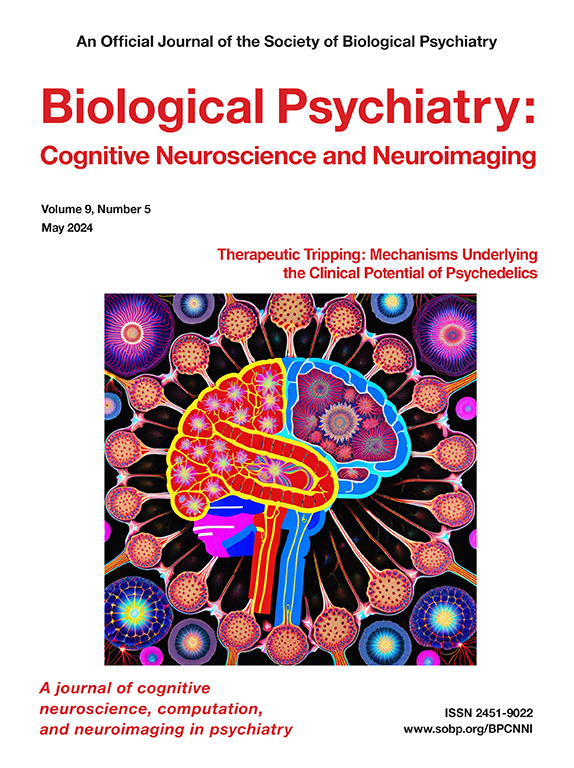Symptom Dimensions and Cognitive Impairments in Individuals at Clinical High Risk for Psychosis
IF 4.8
2区 医学
Q1 NEUROSCIENCES
Biological Psychiatry-Cognitive Neuroscience and Neuroimaging
Pub Date : 2025-06-01
DOI:10.1016/j.bpsc.2024.09.002
引用次数: 0
Abstract
Background
Understanding the intricate relationships between symptom dimensions, clusters, and cognitive impairments is crucial for early detection and intervention in individuals at clinical high risk for psychosis. This study delves into this complex interplay in a clinical high risk sample with the aim of predicting the conversion to psychosis.
Methods
A comprehensive cognitive assessment was performed in 744 clinical high risk individuals. The study included a 3-year follow-up period to allow assessment of conversion to psychosis. Symptom profiles were determined using the Structured Interview for Prodromal Syndromes. By applying factor analysis, symptom dimensions were categorized as dominant negative symptoms (NS), positive symptoms-stressful, and positive symptoms-odd. The factor scores were used to define 3 dominant symptom groups. Latent class analysis (LCA) and the factor mixture model (FMM) were employed to identify discrete clusters based on symptom patterns. The 3-class solution was chosen for the LCA and FMM analysis.
Results
Individuals in the dominant NS group exhibited significantly higher conversion rates to psychosis than those in the other groups. Specific cognitive variables, including performance on the Brief Visuospatial Memory Test–Revised (odds ratio = 0.702, p = .001) and Neuropsychological Assessment Battery Mazes Test (odds ratio = 0.776, p = .024), significantly predicted conversion to psychosis. Notably, cognitive impairments associated with NS and positive symptoms-stressful groups affected different cognitive domains. LCA and FMM cluster 1, which was characterized by severe NS and positive symptoms-odd, exhibited more impairments in cognitive domains than other clusters. No significant difference in the conversion rate was observed among the LCA and FMM clusters.
Conclusions
These findings highlight the importance of NS in the development of psychosis and suggest specific cognitive domains that are affected by symptom dimensions.
精神病临床高危人群的症状维度和认知障碍。
目的:了解症状维度、症状群和认知障碍之间错综复杂的关系,对于早期发现和干预精神病临床高危(CHR)人群至关重要。本研究深入探讨了临床高危人群样本中这种复杂的相互作用,并旨在预测其向精神病的转化:方法:对 744 名临床高危人群进行了全面的认知评估。研究包括为期三年的随访,以评估向精神病的转化情况。采用前驱综合征结构化访谈法确定症状特征。通过因子分析,症状维度被分为占主导地位的阴性症状(NS)、阳性症状-紧张(PS-S)和阳性症状-特殊(PS-O)。因子得分被用来定义三个主要症状组。采用潜类分析(LCA)和因子混合模型(FMM)来识别基于症状模式的离散群组。LCA 和 FMM 分析选择了三类解决方案:结果:NS显性组患者的精神病转化率明显高于其他组。特定的认知变量,包括简明视觉空间记忆测验(Brief Visuospatial Memory Test-Revised)(奇数比,OR=0.702,P=0.001)和神经心理评估测试(Neuropsychological Assessment Battery mazes)(OR=0.776,P=0.024)中的表现,可显著预测向精神病的转化。值得注意的是,与 NS 和 PS-S 相关的认知障碍会影响不同的认知领域。以严重 NS 和 PS-O 为特征的 LCA-1 和 FMM-1 群组比其他群组在认知领域表现出更多的障碍。LCA和FMM群组之间的转换率没有明显差异:这些发现强调了 NS 在精神病发展过程中的重要性,并提出了受症状影响的特定认知领域。
本文章由计算机程序翻译,如有差异,请以英文原文为准。
求助全文
约1分钟内获得全文
求助全文
来源期刊

Biological Psychiatry-Cognitive Neuroscience and Neuroimaging
Neuroscience-Biological Psychiatry
CiteScore
10.40
自引率
1.70%
发文量
247
审稿时长
30 days
期刊介绍:
Biological Psychiatry: Cognitive Neuroscience and Neuroimaging is an official journal of the Society for Biological Psychiatry, whose purpose is to promote excellence in scientific research and education in fields that investigate the nature, causes, mechanisms, and treatments of disorders of thought, emotion, or behavior. In accord with this mission, this peer-reviewed, rapid-publication, international journal focuses on studies using the tools and constructs of cognitive neuroscience, including the full range of non-invasive neuroimaging and human extra- and intracranial physiological recording methodologies. It publishes both basic and clinical studies, including those that incorporate genetic data, pharmacological challenges, and computational modeling approaches. The journal publishes novel results of original research which represent an important new lead or significant impact on the field. Reviews and commentaries that focus on topics of current research and interest are also encouraged.
 求助内容:
求助内容: 应助结果提醒方式:
应助结果提醒方式:


